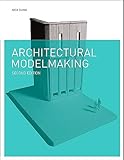Architectural modelmaking / Nick Dunn.
Material type: TextPublisher: London : Laurence King Publishing, 2014Edition: Second editionDescription: 216 pages : illustrations (some color) ; 28 cmContent type:
TextPublisher: London : Laurence King Publishing, 2014Edition: Second editionDescription: 216 pages : illustrations (some color) ; 28 cmContent type: - text
- still image
- unmediated
- volume
- 9781780671727
- 720.22 DU.A 2014 22
| Item type | Current library | Collection | Call number | Status | Date due | Barcode | |
|---|---|---|---|---|---|---|---|
|
|
The Knowledge Hub Library | Design Media | 720.22 DU.A 2014 (Browse shelf(Opens below)) | Not For Loan | 211828 | ||
|
|
The Knowledge Hub Library | Design Media | 720.22 DU.A 2014 (Browse shelf(Opens below)) | Not For Loan | 211829 | ||
|
|
The Knowledge Hub Library | Design Media | 720.22 DU.A 2014 (Browse shelf(Opens below)) | Available | 190493 |
Browsing The Knowledge Hub Library shelves, Collection: Design Media Close shelf browser (Hides shelf browser)

|

|

|

|

|

|

|
||
| 720.108 AG.B 2017 Biomorphic structures / | 720.22 DU.A 2014 Architectural modelmaking / | 720.22 DU.A 2014 Architectural modelmaking / | 720.22 DU.A 2014 Architectural modelmaking / | 720.23 BE.D 2017 Design portfolios : presentation and marketing for interior designers / | 720.23 BE.D 2017 Design portfolios : presentation and marketing for interior designers / | 720.23 LI.P 2012 Portfolio design / |
Includes bibliographical references (page 213) and index.
Introduction : Why we make models -- A brief history -- Modelmaking now -- Getting started -- Machines -- [I.] Media : Introduction : Abstraction ; Size and scale -- The selection and composition of media -- Paper and cardboard : Step by step: Developing a design using paper models -- Wood : Naturally grown woods ; Wood-based sheets -- Step by step: Woodworking -- Styrofoam and plastics : Case study: Using plastics and styrofoam ; Step by step: Making an acrylic model -- Resin, clay and cast materials : Step by step: Casting a plaster model from a silicone mould ; Step by step: Using plasticine to develop form ; Step by step: Casting a concrete model ; Step by step: Casting concrete components -- Steel and other metalwork : Step by step: Modeling a geodesic dome -- CAD/CAM : CNC ; Powder printing ; ABS printing/rapid prototyping -- 3D printing: amalgam modelmaking : CNC milling and routing -- Finishing techniques -- Photography and film : Step by step: Creating a realistic photomontage ; Digital and camera technology ; Case study: Model photography ; Case study: Time lapse and lighting effects -- [II.] Types : Introduction -- Concept models : Case study: From concept to design proposal -- Site/city models -- Block/massing models -- Design development models : Step by step: Making a wax model ; Case study: Process models -- Spatial models : Case study: Spatial models as design generator -- Structural models : Case study: Structural models in the design process -- Interior architecture models : Case study: Exploring light and shadow -- Lighting models : Step by step: Light effects on an interior -- Presentation/exhibition models : Step by step: Making a presentation model ; Case study: Models for an exhibition -- Full-sized prototypes : Case study: Prototype models ; Case study: Material exploration through prototypes ; Step by step: Making a cladding model -- [III.] Application : Introduction -- Descriptive models : Case study: Descriptive model as communication tool ; Case study: Descriptive model as practice -- Predictive models : Case study: Detail models ; Descriptive modelling as hybrid process ; Predictive modelling as technical study -- Evaluative models : Case study: Evaluating material properties ; step by step: Evaluating the effects of a façade -- Explorative models : Case study: Explorative model of urban flows ; Case study: Prototyping through explorative models ; Step by step: Exploring materials through models ; Case study: Exploring new materials through models ; Case study: Explorative models of spatial narratives ; Case study: Taichung Metropolitan Opera House -- Modelling the future : Case study: Integrated making and thinking -- Glossary.
The physical model is an important communication tool for architects. Although the proliferation of CAD programs has enabled the creation of increasingly complex computer models and virtual environments, there is also a growing need to address the three-dimensional qualities of architecture that may be lost when using such media. This book focuses on the inspiring possibilities for modeling the built environment with all the different media and techniques available. In describing the use of different models in different contexts, the book provides a practical guide to how and why models are used and what they are used for. This second edition includes more detailed step-by-step exercises, expanded discussion of materials and techniques, and updated coverage of digital techniques.
There are no comments on this title.

